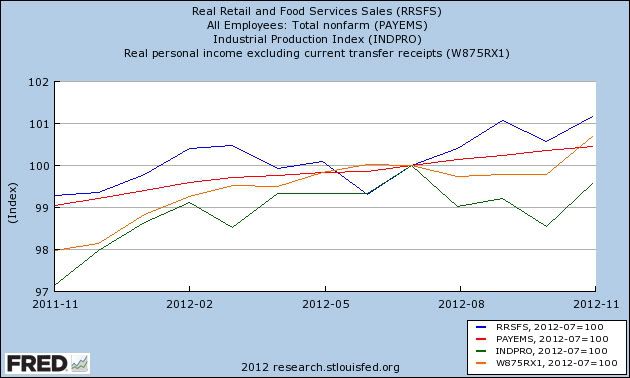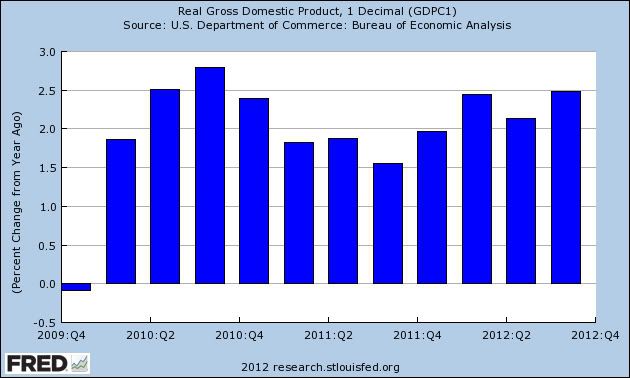- by New Deal democrat
This week I am debuting a new template for this weekly report of the high frequency indicators, which usually signal the direction of the economy well before monthly reports. You won't have to wade through much verbiage, the raw numbers are prominently and simply displaced. This takes any subjective bias by me even further out of the picture. I plan on adding a brief comment at the end of each section. This week in the interest of (my!) time, I've only added it after the first number as a sample. My more general comments follow in the final paragraph. In future weeks I hope to add a little more detail to each data series to help you see the trend. Please let me have your feedback, good or bad.
But first . . . the big monthly data was the December payrolls report, which came in close to estimates at +155,000 jobs and unemployment at 7.8%. November's report was revised higher. Real average hourly wages turned positive YoY for the firt time in nearly 2 years. Auto sales were strong, just slightly below November's post-recession high. ISM manufaccturing returned to slight expansion. ISM services showed stronger expansion. Factory orders were ever so slightly higher. Construction spending declined slightly, but residential spending increased slightly.
Now let's turn to the high frequency weekly indicators:
Housing metrics
Housing prices
- YoY this week. +2.2%
Real estate loans, from the FRB H8 report:
- +0.2% w/w
- +2.2% YoY
- +2.7% from bottom
Mortgage applications
- -14.8% w/w purchase applications
- not reported YoY purchase applications
- -23.4% refinance applications w/w
Interest rates and credit spreads
- -.09% to 4.61% BAA corporate bonds
- -.04% to 1.76% 10 year treasury bonds
- -.05% to 2.85% credit spread between corporates and treasuries
Money supply
M1
- +1.2% w/w
- +2.6% m/m
- +11.9% YoY Real M1
M2
- +3.7% w/w
- +15% m/m
- +6.5% YoY Real M2
Consumer spending
- ICSC +0.6% w/w +2.7% YoY
- Johnson Redbook +2.9% YoY
- Gallup daily consumer spending $86 up $12 YoY
Oil prices and usage
- Oil $93.09 up $2.39 w/w
- gas $3.30 up $.04 w/w
- Usage 4 week average YoY -2.3%
Employment metrics
Initial jobless claims
- 372,000 up 22,000
- 4 week average 360,000 up 3,250
American Staffing Association Index
- 94 flat w/w
Daily Treasury Statement tax withholding
- $194.2 B vs. $175.7 B +10.6% YoY last 20 days
- $185.8 B vs. $162.3 B +14% December monthly YoY
Railroad transport
- -33,800 or -13.8% carloads YoY
- -11,500 or -9% carloads ex-coal
- -25,400 or -14.0% intermodal units
- -59,300 or -13.9% YoY total loads
- 17 of 20 types of carloads down YoY
Shipping transport
- Harpex flat at 362
- Baltic Dry Index up 6 to 706
Bank lending rates
- 0.24 TED spread
- 0.2077 LIBOR
JoC ECRI Commodity prices
- up 0.43 to 126.07 w/w
- +5.22 YoY
Almost all of the high frequency data was either positive or neutral this past week. Initial claims rose significantly, but the 4 week average was the lowest in over 4 years, ex last week. Tax withholding was positive. Temporary jobs were neutral. Consumers continued to spend in line with the trend for the last several years, or even better if you go by Gallup. Credit spreads were accomodative. Real estate loans incresed, although refinancing was hurt due to higher rates. Money supply continued to be very positive and bank lending rates were at new lows. Shipping at least stopped falling. Rail loads this week are best averaged with the excellent data one week ago, and are largely due to YoY anomallies at the end of the year.
Have a nice weekend.






























